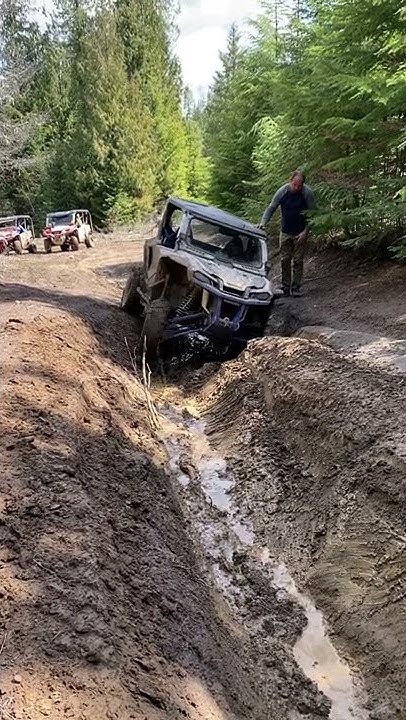Definitely something wrong there. Our group of Talons have tackled some pretty wild stuff in Moab and Sand Hollow (7 and 8 ranked trails) and although i4WD is not perfect, it has never let the "in the air" tire just free spin like you describe. Working correctly, the tire in the air will spin maybe 1/2 turn then i4WD kicks in and up you go.
Maybe they should start by trying the things I listed in this post...
It seems to me after reading a lot of the comments. It depends on a person’s trail riding preference and driving abilities. I’ve taken my 2020 Honda P1000-5 places I really didn’t think it would go. And my Honda is stock. That being said, I don’t take my machine places that I look at it and say...

hondasxs.com
Further investigating while re-assembling my front diff shed some light on just how the Talon and Pioneer diffs really work. They are actually a type of locker that uses torque to basically bind the side gears together and to the inside of the carrier. Similar principal as the Torque Locker just not as abrupt. It is hard without visuals but I will try to explain. Maybe I will make a video since I have my diff all disassembled.
The pinion turns the ring that turns the housing that turns the "Cam Followers". The followers are angled and turn the "Face Cams" (similar part to side gears in a regular diff) at an angle pushing the Cams out against the housing. These cam and followers are positioned/timed so that they also act in a similar manner to side/spider gears (one cam turns clockwise forcing the other to turn counter-clockwise). There is a cone washer (spring) that keeps everything tight. When torque is applied to the ring gear, the followers wedge the cams, pushing them out against the housing, collapsing the cone washer and binding the entire assembly into a bound/locked position.
The main discovery that I uncovered is contrary to how I believed i4WD worked. I always thought that when one wheel slipped, i4WD applied brakes forcing the power through the diff (as if it was an open diff) to the other wheel. This is NOT correct. When one wheel no longer has enough traction, the pressure/torque against the ring gear can be lost and the binding action of the diff is then lost and snaps out of lock mode. When i4WD detects this slippage and applies the brakes, forces the torque back on the assembly and binds the diff back up and locks the front diff again. It applies brakes as long as needed to maintain the bound/locked diff but how it determines that is beyond me.
The other thing I discovered is why the front and rear are different ratios, it is by design and makes the front diff lock engage when going straight. In 4WD, the different ratios force the front to apply and keep torque against the cams and followers and locks the front end up as long as you are going straight (or almost straight). When you turn, the outer tire starts to rotate faster, unbinding the diff and around the corner you go without the diff locked. Once you straighten back up, the diff locks up again. Those of us that are using different tire pressures to try to make up for the gear difference are actually reducing the front diff's locking effectiveness.
The front diff locking mechanism requires some traction to make the cam/followers bind/lock. This is why i4WD doesn't do very well in the snow or mud (and sometimes sand), there is not enough traction in the front end to cause pressure against the cam/followers to engage the locker. Even when i4WD attempts to create that pressure, the tire with the most traction doesn't have enough to create the needed pressure to lock the diff so the system "hunts" and just switches braking left, right, left, right, etc. In the snow and sand, this is probably what causes that dreaded "hopping". It would probably be better to use a bypass in these situations so i4WD doesn't "hunt".
During the assembly measuring process, my spring loaded backlash was measured at .55mm (.023") but is supposed to be .15mm (.006"). That doesn't seem like much difference but it is almost 4 times what the service manual says. That means that my cam/followers must move almost 4 times as much to bind/lock the front diff and that has to create some lag or inefficiency in the system. I believe that if that backlash is excessive, it may cause the diff to slowly or never lock up and therefore i4WD will react very slow or possibly not work work at all. I have ordered the correct shim to get the backlash down to the .15mm mark.
Another thing that peaked my curiosity after determining the diff uses friction/binding to lock is the gear oil. I was using synthetic with friction modifier. All you can really get off the shelf is oil with friction modifiers in it. Problem is that synthetic plus FM may create less friction than the gear oil speced by Honda for the front diff, causing less friction and hampering the binding/locking of the diff. They specifically call for 80W-90 GL5 Honda Shaft Drive Oil or equivalent and Honda Shaft Drive Oil does not contain friction modifiers. I believe that the oil I was using may be too slippery and may reduce the locking affect of the front diff so I am sourcing some 80W-90 without friction modifiers for my front diff.



